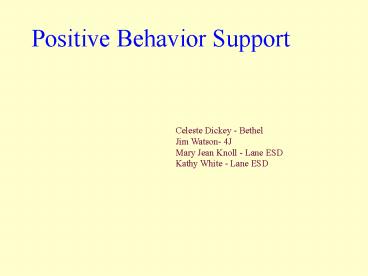Celeste Dickey Bethel - PowerPoint PPT Presentation
1 / 27
Title:
Celeste Dickey Bethel
Description:
Celeste Dickey - Bethel. Jim Watson- 4J. Mary Jean Knoll - Lane ESD. Kathy White - Lane ESD ... Write down an example of a problem behavior. Share with your group ... – PowerPoint PPT presentation
Number of Views:36
Avg rating:3.0/5.0
Title: Celeste Dickey Bethel
1
Positive Behavior Support
Celeste Dickey - Bethel Jim Watson- 4J Mary Jean
Knoll - Lane ESD Kathy White - Lane ESD
2
Problem Behaviors? Who, us?
- Write down an example of a problem behavior
- Share with your group
- Brainstorm results of these problem behaviors on
- 1. The student involved
- 2. Other students
- 3. Teachers and staff
- One person in each group share with all of us a
1, 2 and 3
3
Solutions?
- Get tough. Get tougher! Zero tolerance!!
Suspend!!! Expel!!!! - Train and hope
- A systems approach
4
A Systems Approach PBS/EBS
5
Triangulating behaviors
- Where does the behavior you listed fit in the
triangle? - Does a high percentage of students exhibit it?
- Is it mainly confined to a group of 3-15 (or so)
students? - Or is it just one or two students causing all
this grief? - Where do we start - red, yellow or green?
- Drum roll, please.
6
Start with school-wide systems
Provides Context
Establishes Climate
Reduces the Tip
7
What does it take?
- FIRST Data
- What systems and programs do you have in place?
- What are the problem behaviors?
- How many students are involved?
- Do students and staff describe the climate as
safe? - Is the climate conducive to learning?
- Are behavioral expectations clear and universally
known?
8
What does it take?
- SECOND Systems (to support staff behavior)
- Buy-in
- A representative team
- Active administrative support
- Communication systems
- A school-wide implementation plan
- Resources
- Buy-in becomes commitment
9
What does it take?
- THIRD Practices (supporting student behavior)
- Enthusiastic staff involvement
- Expectations taught
- Consistent acknowledgement
- Consistent correction
- Data based decision-making
- Monitoring and adjustment
10
Putting it all together!
11
EBS/PBS is...
- A building-based team approach
- An investment of time and energy to learn new
skills and develop systems - A way to build on existing strengths
- A process able to flex to fit a schools
situation - Practical, effective and validated
- Enduring
12
EBS/PBS is not...
- A top-down approach (staff buy-in is crucial)
- A quick fix for behavior problems (3-5 years)
- An off-the-shelf, ready-to-use program
(developed by the team to fit the school) - Administrator-free (the principal or assistant
principal on the team is essential
13
EBS/PBS Implementation Layer Cake
14
Does EBS/PBS Work? Some Data
15
Does EBS/PBS Work? Some Data
16
Does EBS/PBS Work? Some Data
17
Does EBS/PBS Work? Some Data
One EBS Schools Attendance
18
Does EBS/PBS Last?
19
Unfortunately, the data doesnt always look that
good
20
But, with work to reinvest in critical features .
. . Same school, one year later
21
After the break How does it happen?
- How can you get buy-in?
- How can get administrator support?
- Who might be on the team and who will lead it?
- How might we establish 3-5 universal rules?
- What will we teach? Where? Who will do it?
- How can we acknowledge and correct student
behavior? - How might data be collected and used?
- How will we know if it is working and how to
improve it?
22
Designing School-Wide Systems for Student Success
1-5
1-5
5-10
5-10
80-90
80-90
23
Number of Referrals
24
Reduction of Referrals
- Elementary Middle Schools
- Between 2000-01 2002-03
- Increased enrollment (220 students)
- Decreased referrals (-988 referrals)
- Increased Administrator time
- 998 referrals _at_ 15 min per referral
- 249.5 hours of Administrator Time saved
- 998 referrals _at_ 30 min per referral
- 499 hours of Administrator Time saved
25
Increased Academic Time
- Reduction in Referrals
- Increased academic time for students
- Increased time for administrators to focus on
academic leadership - Decreased classroom disruptions
- Improvement in school-wide environment
26
Red Zone Referrals
27
Triangle/Referrals
- 80-85 of Students 0-1 Referrals Green Area
- 5-10 of Students 2-5 Referrals Yellow Area
- 1-5 of Students 6 Referrals Red Area































